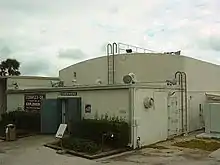Cape Canaveral Launch Complex 26
Launch Complex 26 (LC-26) is a deactivated launch site at Cape Canaveral Space Force Station, Florida. LC-26 consisted of two pads, A and B. Pad A was used for the Jupiter-C and Juno I rockets, and was the launch site for Explorer 1, the United States' first satellite, in 1958. Pad B was used for Juno II. Jupiter IRBMs were launched from both pads.

In its early years, it was used to launch ballistic missiles on test flights, and could have been used for a nuclear strike against the Soviet Union if nuclear war had begun.
On February 1, 1958 (January 31 local time), the US Army Ballistic Missile Agency launched Explorer 1 from LC-26A.
LC-26 is also the home of the Air Force Space and Missile Museum. Access to the museum at LC-26 as well as the adjoining LC-5 and LC-6 by the general public can be arranged through the Kennedy Space Center Visitor Center "Cape Canaveral Early Space Tour". The Cape Canaveral Space Force Station also offers monthly tours.
External links
 Media related to Cape Canaveral Air Force Station Launch Complex 26 at Wikimedia Commons
Media related to Cape Canaveral Air Force Station Launch Complex 26 at Wikimedia Commons- Air Force Space and Missile Museum virtual tour
- video clip of LC 26 blockhouse tour
- Official Air Force Space and Missile Museum website
- Spherical panoramas of Launch Complex 26 and Museum